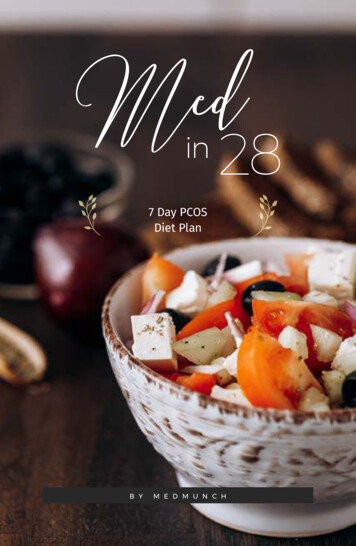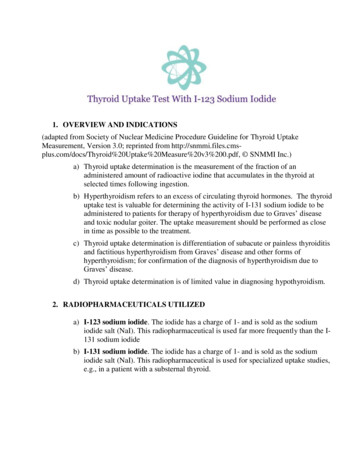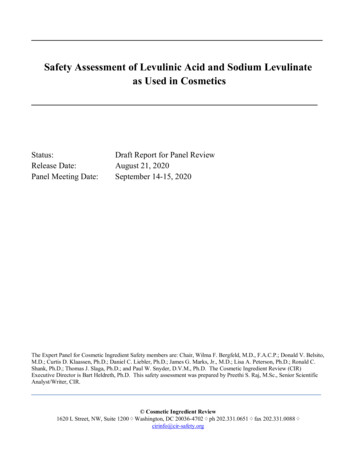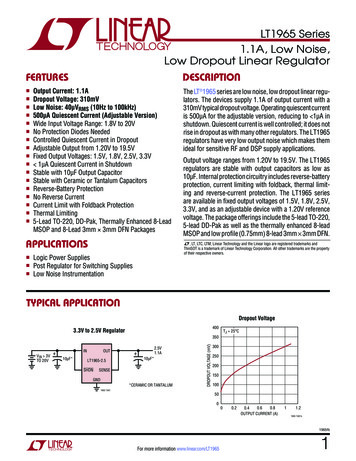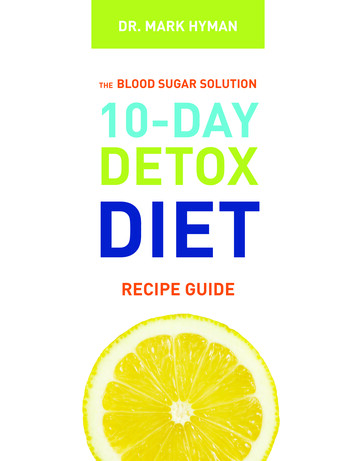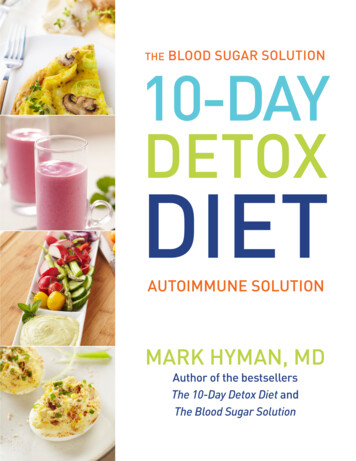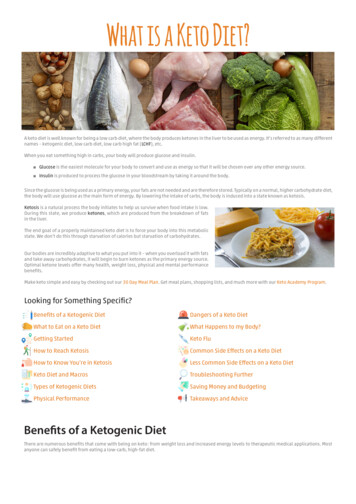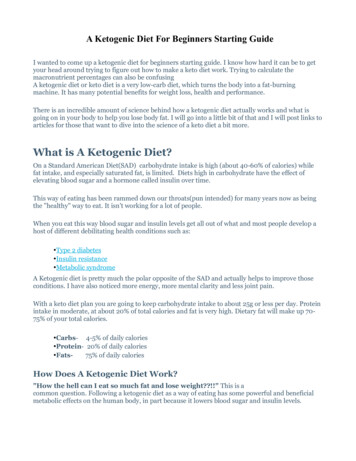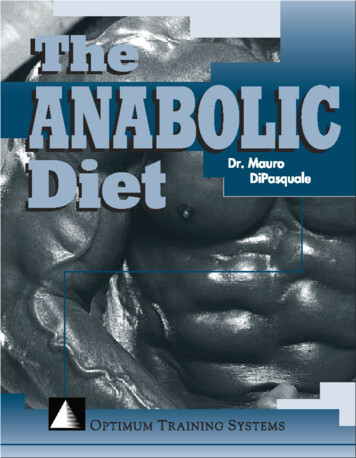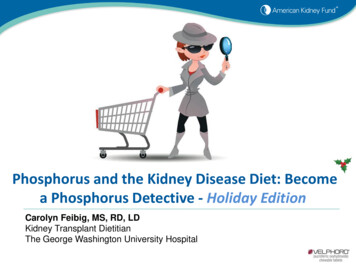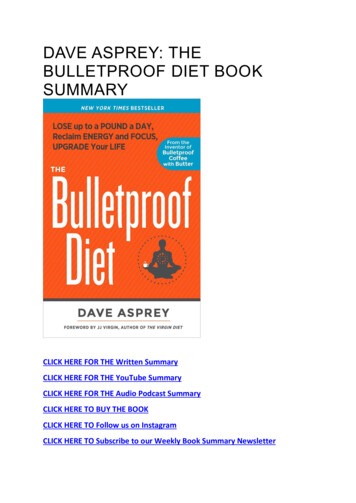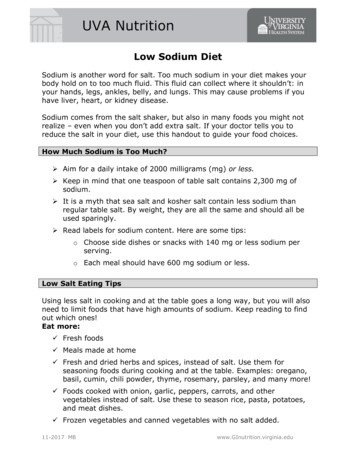
Transcription
Low Sodium DietSodium is another word for salt. Too much sodium in your diet makes yourbody hold on to too much fluid. This fluid can collect where it shouldn’t: inyour hands, legs, ankles, belly, and lungs. This may cause problems if youhave liver, heart, or kidney disease.Sodium comes from the salt shaker, but also in many foods you might notrealize – even when you don’t add extra salt. If your doctor tells you toreduce the salt in your diet, use this handout to guide your food choices.How Much Sodium is Too Much? Aim for a daily intake of 2000 milligrams (mg) or less. Keep in mind that one teaspoon of table salt contains 2,300 mg ofsodium. It is a myth that sea salt and kosher salt contain less sodium thanregular table salt. By weight, they are all the same and should all beused sparingly. Read labels for sodium content. Here are some tips:o Choose side dishes or snacks with 140 mg or less sodium perserving.o Each meal should have 600 mg sodium or less.Low Salt Eating TipsUsing less salt in cooking and at the table goes a long way, but you will alsoneed to limit foods that have high amounts of sodium. Keep reading to findout which ones!Eat more: Fresh foods Meals made at home Fresh and dried herbs and spices, instead of salt. Use them forseasoning foods during cooking and at the table. Examples: oregano,basil, cumin, chili powder, thyme, rosemary, parsley, and many more! Foods cooked with onion, garlic, peppers, carrots, and othervegetables instead of salt. Use these to season rice, pasta, potatoes,and meat dishes. Frozen vegetables and canned vegetables with no salt added.11-2017 MBwww.GInutrition.virginia.edu
Eat less: Fast food and take-out like Chinese food and pizza Store bought canned foods, unless the label says “no salt added” Canned soups, unless they are Low Sodium varieties. See the sectionon reading labels below. Processed foods like potato chips and Oreos Ready-made meals like boxed rices and TV dinners Jarred condiments like salsa, pickles, and olivesReading Nutrition LabelsYou should get in the habit of checking food labels for the most up-to-dateinformation. Sodium is always on the food label. These steps will help youfigure out how much sodium is in a certain food:1. Number of servings and mg of sodium – The label gives you theserving size and the number of servings in the package. The NutritionFacts apply to the serving size listed on the label, not necessarily tothe whole package. Remember, if the serving size is 1 cup and you eator drink 2 cups, you must multiply the amount of sodium by 2. (Thesame goes for the calories, etc.)2. Look at the ingredients – Beware of products that list “salt,”“sodium,” and “monosodium glutamate” as one of the first fiveingredients.11-2017 MBwww.GInutrition.virginia.edu
3. Compare brands – The sodium content of a particular food may varyfrom brand to brand. Be sure you are comparing similar serving sizes.Remember, those foods labeled as reduced sodium contain at least25% less sodium than the regular variety. For example, a reducedsodium frozen entrée may have 600 mg sodium instead of 800 mgsodium in the regular version.There are laws that regulate what certain words and phrases mean on thefront of food labels. The table below explains what food companies areallowed to say. But remember, the serving you actually eat may not beexactly the same as the suggested serving on the nutrition label.Label TermSodium-FreeVery Low SodiumLow SodiumReduced or less sodiumUnsalted, no saltadded, without addedsaltMeaningLess than 5 mg of sodium per serving35 mg or less of sodium per serving140 mg or less of sodium per servingAt least 25% less sodium than a serving size of theoriginal productMay contain sodium as a natural part of the food,but no additional sodium or salt is added duringprocessingWhat to Eat: The SpecificsFood Group:Choose these lowersodium foods:Limit these high sodiumfoods: Breads, Grains,and Cereals 11-2017 MBLoaf bread, dinner rolls,English muffins, bagels(limit to 2-3 servings daily)Plain pasta, noodles, plainriceWhite or sweet potatoes,unsaltedDried beans, peas, andlentils (cook with onionand garlic for flavor);Unsalted hot cereals likeoatmeal and wheat farinaUnsalted or low sodiumsnack foods (read labels,some chips are low in salt)Low sodium ready to eatcereals such as puffed rice,cornflakes, oat Os,shredded wheat Biscuits and BisquickPancake, muffin, andcornbread mixesSeasoned rice and noodlemixes like ramen noodles,Noodle Roni , Rice-a-Roni ,macaroni and cheeseCoating mixes like seasonedbread crumbs,Shake’n’Bake Salted snacks like potatochips, nachos, peanutbutter crackers, pretzels,pork rinds)Instant mashed potatoeswww.GInutrition.virginia.edu
Food Group:Choose these lowersodium foods:Limit these high sodiumfoods: Dairy MilkYogurtCream cheese, especiallywhippedSour creamIce cream and frozenyogurtWhipped creamLow sodium cheeses:Swiss, mozzarella, gratedParmesanNote: Low Fat does not meanlow sodium! Read the labels, cheese variesin sodium content. All fruits and fruit juices No need to limit any!(Canned fruits do notcontain sodium.) Unsalted butterLardOlive or vegetable oilTub or squeeze margarineLow sodium or homemadesalad dressingsMayonnaiseFresh or dried herbs andspicesVinegar, lemon juice andfruit juices for marinadesOnion and garlic (fresh,minced, dried in flakes orpowdered)Pepper, celery seed, anddried vegetable flakesMustard, low sodiumbouillonSpice and herb blendswithout added salt (Mrs.Dash ) Bacon and bacon greaseSalt porkFat backRegular commercial saladdressings Salt, sea salt, lite salt,bouillon cubesPotassium-containing saltsubstitutes (Nu-Salt , NoSalt )Seasoning salts (garlic salt,onion salt, celery salt)Spice and herb mixes withadded salt, including OldBay Commercially preparedsauces (teriyaki, soy)Large amounts of ketchupor BBQ sauceFruitsFats Seasonings andcondiments 11-2017 MBButtermilkProcessed cheeses:American, Nacho cheese,Cheez Whiz , Easy Cheese Blue cheesePimento cheeseCottage cheeseQueso frescoFeta cheese www.GInutrition.virginia.edu
Some Foods Should Always Be AvoidedSome foods are extremely high in sodium. You should avoid these foods inyour diet as much as possible. The good news is, there are reduced sodiumvarieties of many of these foods!Processed deli meatsSausageBaconHot dogsCanned meatsSmoked or cured meats (pepperoni,salami, etc.)Breaded meats, fish, poultryProcessed cheese products (CheezWiz , Velveeta , etc.)PicklesCanned vegetables and vegetablejuices that are not “reduced sodium”or “no salt added”OlivesBiscuitsSalted snack foods (pretzels, etc.)Seasoned rice (Rice-A-Roni , etc.)11-2017 MBSalt porkFat backRegular salad dressingsSaltBouillonSeasoning saltsSoy sauceWorcestershire sauceRegular canned soupsDry soup mixesFrozen mealsFast foodCanned tomato products, spaghettisauce, tomato, or V-8 juiceNoodle or potato mixeswww.GInutrition.virginia.edu
11-2017 MB www.GInutrition.virginia.edu 3. Compare brands – The sodium content of a particular food may vary from brand to brand. Be sure you are comparing similar serving sizes. Remember, those foods labeled as reduced sodium c
